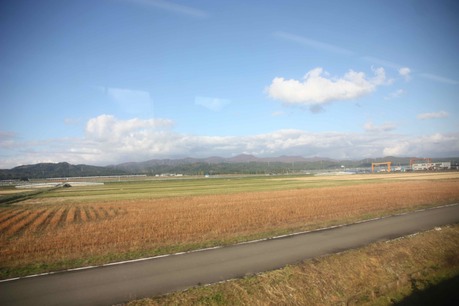
Modern Aomori owes much of its status (apart from the lurks and perks associated with being the prefectural capital) to its position at the terminus of those two rail lines and role as the port for the Seikan Ferry line, which opened in 1908, sailed between Aomori and Hakodate nearly three-quarters of a million times, carrying 160 million passengers until the Seikan Tunnel, the longest tunnel of its kind in the world, came into service.
The Tōhoku Expressway connected Aomori to Tokyo by highway in 1979 and the city is currently the northern terminus of Japan's Shinkansen service, though that will change in the not too distant future when the new bullet train line goes in under the Tsugaru Strait. We saw fairly obvious signs that construction of that line is well and truly under way.
Sighting the ferry on the way to the morning train was a reminder of those matters,
From Aomori the line more or less followed the coast, with views across the water to Hokkaido, though what I first thought to be the northern island turned out, on closer inspection, to be the northeastern arm of Honshu. Blue sky, bright sunshine meant it was sunglasses weather, not exactly conducive to typing, but that would be caught upon the half hour haul under the Tsugaru Strait.
We were running right beside the beach as we came into Kanita, and there was a lengthier than usual delay due to problems on the other side. From Kanita the line started to move inland, with deep green forests on either side and broad swathes of multicoloured leaves interspersed among the evergreens, though there were paddy fields closer to the line itself.
By 9:03 we were starting to run into tunnels, the first of them relatively short, and by 9:05 we’d reached a longer one, emerging again by 9:08, when we were supposed to be hitting the big one. The train came to a halt at Tsugaru Hamana, and when we were underway again, with water clearly visible on the left at 9:11 we were in another tunnel, not quite the one that meant our next sighting of daylight would've on Hokkaido, and there were more as we made our way under coastal ridges running down to the sea, which was still over there on our left.
The false alarms meant I wasn't sure whether the tunnel we hit at 9:14 was the big one, but given the fact that we were still hurtling through the darkness two minutes later, I guess it was.
We were supposed to hit the bottom at 9:22, two hundred and forty metres down in a tunnel ten metres wide and eight metres high,though there was no way of assessing dimensions in the Stygian gloom outside. It was a major engineering feat, some forty-two years in the making.